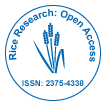Improvement of Rice Yield Through Genetic Engineering
Received: 02-Nov-2024 / Manuscript No. rroa-25-158948 / Editor assigned: 04-Nov-2024 / PreQC No. rroa-25-158948(PQ) / Reviewed: 18-Nov-2024 / QC No. rroa-25-158948 / Revised: 23-Nov-2024 / Manuscript No. rroa-25-158948(R) /
Abstract
Genetic engineering holds great promise for improving rice yield by introducing beneficial traits such as disease resistance, drought tolerance, and enhanced nutritional content. In this study, we investigate the application of genetic modification techniques for enhancing rice production. Through the incorporation of specific genes into rice plants, we aimed to improve their resistance to pests, stress tolerance, and overall productivity. The results indicate that genetically modified rice strains outperform traditional varieties in terms of yield and resilience.
Keywords
Genetic Engineering; Rice Yield; Disease Resistance; Drought Tolerance; Genetic Modification
Introduction
Rice is a vital staple crop that sustains over half of the world’s population. However, as global demand for rice continues to increase, challenges such as pest infestations, diseases, water scarcity, and fluctuating climatic conditions are hindering production. Traditional breeding techniques, while successful in some instances, have limitations in their ability to address these complex issues in a timely manner. Genetic engineering has emerged as a promising solution to enhance rice yield and resilience. Through the insertion of specific genes, scientists have been able to create rice varieties that possess enhanced resistance to pests, improved tolerance to environmental stressors like drought, and higher nutritional content. The application of genetic engineering to rice has gained considerable attention due to its potential for achieving significant improvements in crop productivity. For example, genetically modified (GM) rice varieties that are resistant to insect pests like the rice stem borer or have greater water use efficiency are increasingly being explored. Additionally, the development of genetically modified rice with improved nutritional profiles—such as Golden Rice, which is enriched with provitamin A—has the potential to address micronutrient deficiencies in regions where rice constitutes a major portion of the diet. This research investigates the role of genetic engineering in improving rice yield through the introduction of specific genetic traits that enhance resilience to pests, diseases, and environmental stresses, while also boosting nutritional content. The findings of such research can lead to more sustainable and higher-yielding rice varieties, contributing to food security in a rapidly changing world. With proper regulations and continued research, genetically engineered rice could play a key role in meeting the growing demand for food in the face of global population growth and environmental challenges [1-6].
Discussion
The use of genetic engineering to enhance rice production has been explored in various ways. One key area of focus is the development of pest-resistant rice. The incorporation of genes that produce proteins toxic to pests, such as the Bacillus thuringiensis (Bt) gene, has been shown to reduce crop damage and increase yield. Additionally, drought tolerance is a major concern for rice farmers in regions facing water scarcity. Genes such as the drought-induced protein (DIP) gene and aquaporins have been successfully integrated into rice plants, resulting in enhanced water use efficiency and better survival under dry conditions. Another critical area of research is the biofortification of rice. Rice is a poor source of essential micronutrients, such as iron and zinc, which can lead to malnutrition. Genetic modifications that increase the levels of these nutrients in rice have been developed and show promising results in improving nutritional outcomes in regions suffering from micronutrient deficiencies.
Furthermore, rice yield enhancement is not limited to genetic modifications alone but also involves the optimization of agricultural practices and efficient resource use. Improved rice cultivation techniques, such as the use of hybrid varieties, better soil management, and precision farming, complement genetic improvements and can significantly boost yield [7-10].
Conclusion
Genetic engineering offers substantial opportunities to address the challenges faced by rice farmers. By introducing traits such as disease resistance, drought tolerance, and improved nutritional content, genetically modified rice varieties have the potential to significantly enhance rice productivity and sustainability. However, careful regulatory oversight and long-term studies on environmental and health impacts are necessary to ensure the safe and responsible adoption of these genetically engineered crops. The combination of biotechnology and sound agricultural practices promises to contribute to global food security in the face of growing population pressures and climate change.
References
- Ashby JA (2009)The impact of participatory plant breeding.Plant breeding and farmer participation 649-671.
- Bellon MR (1991)The ethno-ecology of maize variety management: a case study from Mexico.Human Ecology 19: 389-418.
- Qazi HA, Rao PS, Kashikar A, Suprasanna P, Bhargava S (2014)Alterations in stem sugar content and metabolism in sorghum genotypes subjected to drought stress. Funct Plant Biol 41: 954-962.
- Biggs S (2008)The lost 1990s? Personal reflections on a history of participatory technology development.Development in Practice 18: 489-505.
- Ceccarelli S, Grando S (2019)From participatory to evolutionary plant breeding. InFarmers and Plant Breeding231-244.
- Ceccarelli S (2012)Landraces: importance and use in breeding and environmentally friendly agronomic systems.Agrobiodiversity conservation: securing the diversity of crop wild relatives and landraces. CAB International 103-117.
- Ceccarelli S, Grando S, Tutwiler R, Baha J, Martini AM, et al. (2000)A methodological study on participatory barley breeding I. Selection phase.Euphytica111: 91-104.
- Ceccarelli S, Guimarães EP, Weltzien E (2009)Plant breeding and farmer participation. Food and Agriculture Organization of the United Nations, Rome, Italy.
- Chiffoleau Y, Desclaux D (2006)Participatory plant breeding: the best way to breed for sustainable agriculture?Int J Agric Sustain 4: 119-130.
- Cleveland DA, Daniela S, Smith SE (2000)A biological framework for understanding farmers’ plant breeding.Economic Botany54: 377-394.
Indexed at, Google Scholar, Crossref
Share This Article
Recommended Journals
Open Access Journals
Article Usage
- Total views: 342
- [From(publication date): 0-0 - Apr 05, 2025]
- Breakdown by view type
- HTML page views: 181
- PDF downloads: 161
